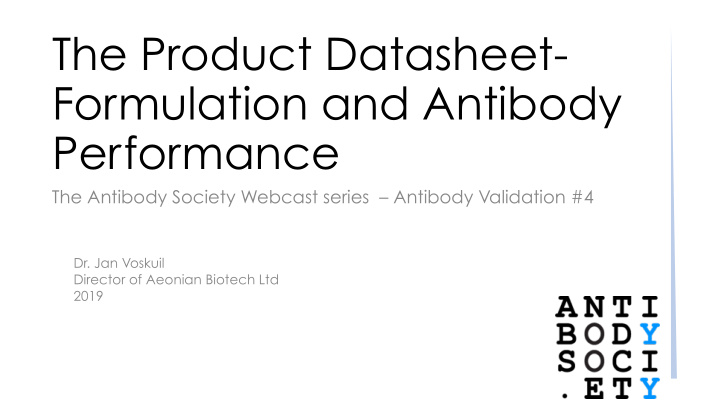



The Product Datasheet- Formulation and Antibody Performance The Antibody Society Webcast series – Antibody Validation #4 Dr. Jan Voskuil Director of Aeonian Biotech Ltd 2019
What to look for when shopping around? • Be convinced that your choice will meet your expectations. • Performance must be consistent from purchase to purchase. • Product ideally will still exist and remains available 10-20 years later! • The Product Datasheet provides the clues: Claims of performance: Fixed parameters: • Application claims • Catalog number and batch/clone • Titre in ELISA number • Names and symbols of protein • Positive controls (tissues; cell types; cell lines) • GeneID and/or SwissProt accession • Successful usage claims in literature • Host species and isotype • Data confirming molecular integrity • Antigen & Epitope • Data confirming no cross-reactivity to closely related proteins • Purification method • Formulation (buffer components) • Negative controls • Amount (mg or ml) • Data confirming successful use in applications
What are the pitfalls to watch for? Fixed parameters: Shared Symbols . e.g.: OCT2 (SLC22A2, GeneID 6582 and POU2F2, GeneID 5452) Renamed clones . e.g.: re-cloned hybridoma Batch-to-batch inconsistency . e.g.: is next purchase from different animal or different purification Aliquots from the same batch may differ in performance due to storage/handling history Are you buying volumes or quantities ? Has the antibody been purified, and how ? (e.g. NH 3 SO 4 -cut; Protein A; or antigen affinity) Do you need a domain-specific or epitope-specific antibody ? In what formulation is the antibody offered (buffer components)?
What are the pitfalls to watch for? Performance parameters: Are the claimed applications supported by data (from literature or datasheet?) Do the data presented comply with the science (example: is detection in correct cell compartment or tissue) Are data presented fit-for-purpose? (wrong: FC on cell line; ICC staining entire cells; IHC with blurred stains) Each application is demonstrated under different conditions (tested on peptide, protein, cell type, etc) Is the antibody compared with another gold-standard one? Has the antibody been tested on both expressing and non-expressing cells/tissues? Has the antibody been tested on closely related proteins (from the same protein family) ? Are comparisons all done at the same time and at the same dilution/antibody concentration ?
Summary • Vendor may provide evidence, but scientist must verify. • Choose antibody shown fit for the assay type you need it for. • Ensure the antibody works in the cell types you need it for. • Selectivity (correct negatives) trumps specificity (correct positives) Read more on the subject: Voskuil (2017) The challenges with the validation of research antibodies. F1000Res 6:161 .
What antibody have I found? The Antibody Society Webcast series – Antibody Validation #4 Anita Bardowski UCSD; SciCrunch Jan Voskuil Aeonian Biotech
Next Webcast in Antibody Validation: a 9-part series The different antibody formats Andreas Pluckthun : 1. : Antibodies and the reproducibility crisis in biological science 2. Glenn Begley : The Erß story – is your antibody like this? Cecilia Williams : Beware the supplier OEM 3. Jan Voskuil Finding antibodies in the Antibody Databases Andy Chalmers : Which antibody are you looking for? The RRID Anita Bardowski : 4. Points to note on the supplier datasheets Jan Voskuil : Correct positive and negative controls in validation 5. Giovanna Roncador: : : Standard technology: “even” Western blots are non-trivial 6. Aldrin Gomes : IHC issues in brain sciences Jim Trimmer : Cell KO technology Travis Hardcastle 7. : Validating Antibodies with KO technology Alejandra Solache Validating antibodies using array technologies 8. Mike Taussig : Mass spectroscopy for mass validation Fridjhof Lund-Johansen : Why publish sequences? Andrew Bradbury : 9. Andreas Pluckthun : What are the coming alternatives ?
Validation of Commercial tool Antibodies What antibody have I found? The Antibody Society Webcast series – Antibody Validation #4 Presented by Anita Bandrowski and Jan Voskuil Produced and Directed by Simon L. Goodman Technical Assistance and Editing Fran Breden Writen by Simon Goodman https://www.antibodysociety.org/
Validation of Commercial Tool Antibodies An Antibody Society Webcast series https://www.antibodysociety.org/ Administrative Support: Dr. Fran Breden and Dr. Mini Muralidharan Executive Director: Dr. Jan Reichert This series would be impossible without the generous financial support of our Corporate Sponsors: Contact us at info@antibodysociety.org or +1 (508) 808-8311 to become a corporate sponsor!
Recommend
More recommend